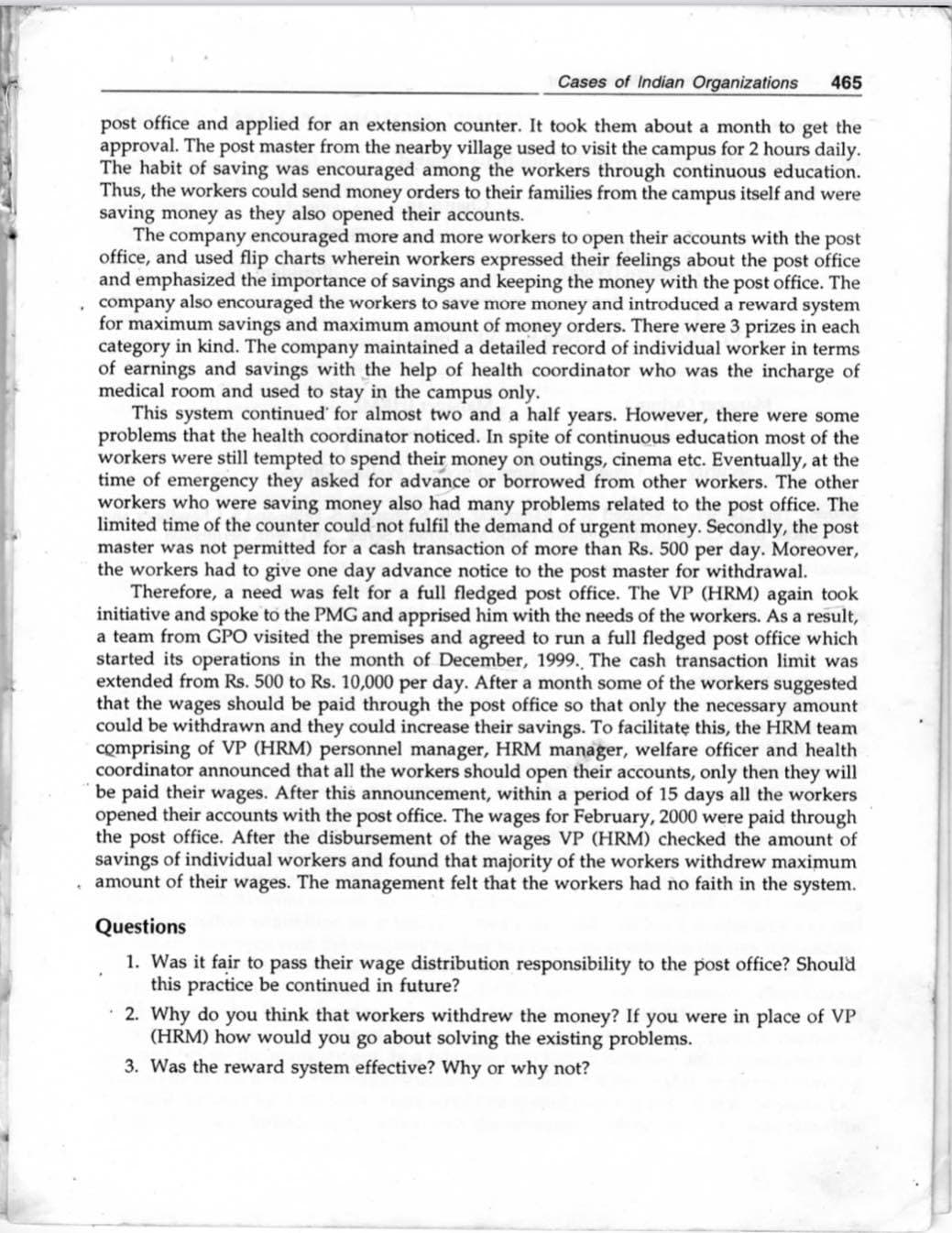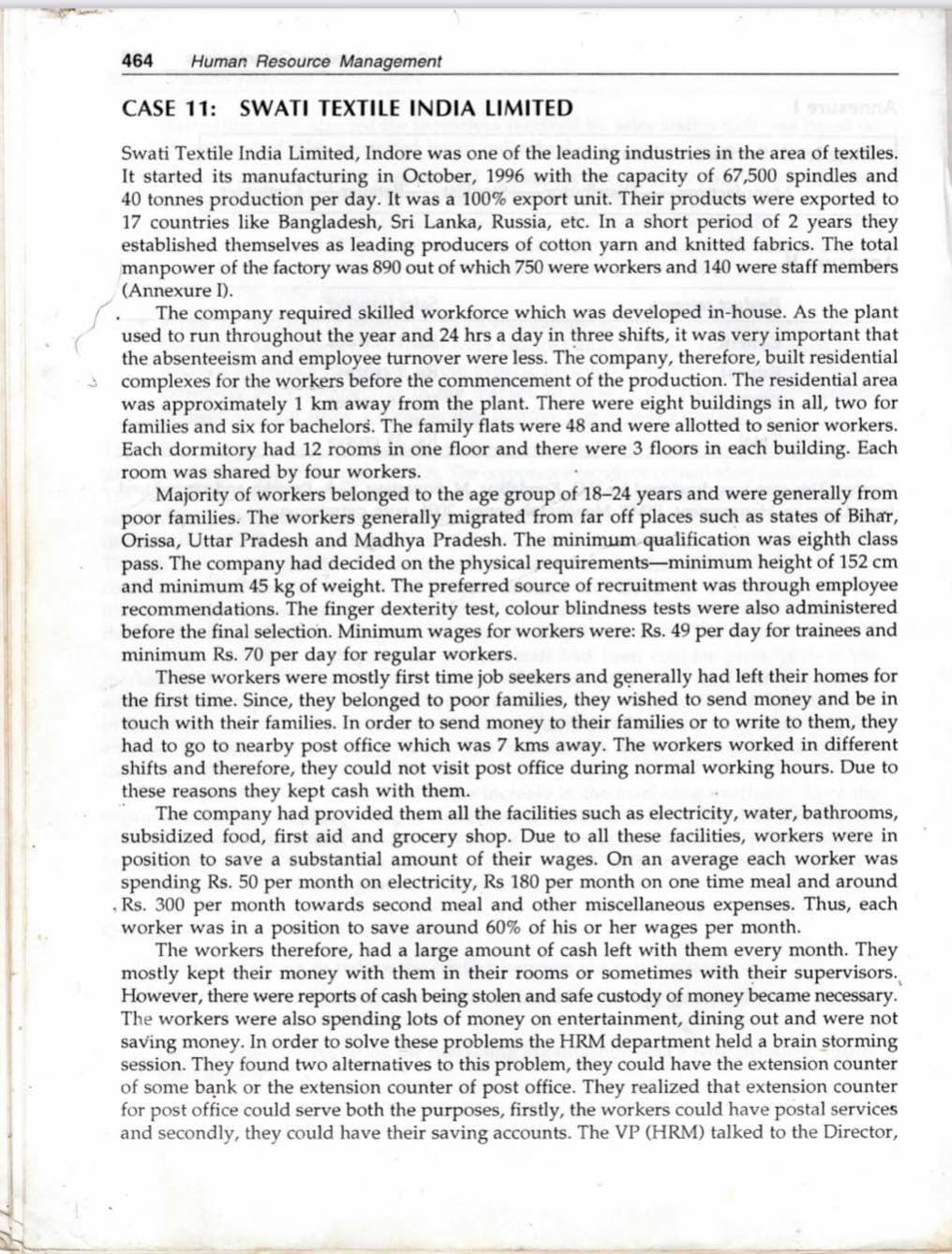Was it fair to pass their wage distribution responsibility to the post office? Should this practice be continued in future? 2. Why do you think that workers withdrew the money? If you were in place of VP (HRM) how would you go about solving the existing problems. 3. Was the reward system effective? Why or why not?
Was it fair to pass their wage distribution responsibility to the post office? Should this practice be continued in future? 2. Why do you think that workers withdrew the money? If you were in place of VP (HRM) how would you go about solving the existing problems. 3. Was the reward system effective? Why or why not?
Management, Loose-Leaf Version
13th Edition
ISBN:9781305969308
Author:Richard L. Daft
Publisher:Richard L. Daft
Chapter7: Planning And Goal Setting
Section: Chapter Questions
Problem 2ED
Related questions
Question
Read the case carefully and answer the questions.
QUESTION :
1. Was it fair to pass their wage distribution responsibility to the post office? Should this practice be continued in future?
2. Why do you think that workers withdrew the money? If you were in place of VP (HRM) how would you go about solving the existing problems.
3. Was the reward system effective? Why or why not?

Transcribed Image Text:Cases of Indian Organizations
465
post office and applied for an extension counter. It took them about a month to get the
approval. The post master from the nearby village used to visit the campus for 2 hours daily.
The habit of saving was encouraged among the workers through continuous education.
Thus, the workers could send money orders to their families from the campus itself and were
saving money as they also opened their accounts.
The company encouraged more and more workers to open their accounts with the post
office, and used flip charts wherein workers expressed their feelings about the post office
and emphasized the importance of savings and keeping the money with the post office. The
company also encouraged the workers to save more money and introduced a reward system
for maximum savings and maximum amount of money orders. There were 3 prizes in each
category in kind. The company maintained a detailed record of individual worker in terms
of earnings and savings with the help of health coordinator who was the incharge of
medical room and used to stay in the campus only.
This system continued for almost two and a half years. However, there were some
problems that the health coordinator noticed. In spite of continuous education most of the
workers were still tempted to spend their money on outings, cinema etc. Eventually, at the
time of emergency they asked for advance or borrowed from other workers. The other
workers who were saving money also had many problems related to the post office. The
limited time of the counter could not fulfil the demand of urgent money. Secondly, the post
master was not permitted for a cash transaction of more than Rs. 500 per day. Moreover,
the workers had to give one day advance notice to the post master for withdrawal.
Therefore, a need was felt for a full fledged post office. The VP (HRM) again took
initiative and spoke to the PMG and apprised him with the needs of the workers. As a result,
a team from GPO visited the premises and agreed to run a full fledged post office which
started its operations in the month of December, 1999. The cash transaction limit was
extended from Rs. 500 to Rs. 10,000 per day. After a month some of the workers suggested
that the wages should be paid through the post office so that only the necessary amount
could be withdrawn and they could increase their savings. To facilitate this, the HRM team
comprising of VP (HRM) personnel manager, HRM manager, welfare officer and health
coordinator announced that all the workers should open their accounts, only then they will
be paid their wages. After this announcement, within a period of 15 days all the workers
opened their accounts with the post office. The wages for February, 2000 were paid through
the post office. After the disbursement of the wages VP (HRM) checked the amount of
savings of individual workers and found that majority of the workers withdrew maximum
· amount of their wages. The management felt that the workers had no faith in the system.
Questions
1. Was it fair to pass their wage distribution responsibility to the post office? Should
this practice be continued in future?
2. Why do you think that workers withdrew the money? If you were in place of VP
(HRM) how would you go about solving the existing problems.
3. Was the reward system effective? Why or why not?

Transcribed Image Text:464
Human Resource Management
CASE 11: SWATI TEXTILE INDIA LIMITED
Swati Textile India Limited, Indore was one of the leading industries in the area of textiles.
It started its manufacturing in October, 1996 with the capacity of 67,500 spindles and
40 tonnes production per day. It was a 100% export unit. Their products were exported to
17 countries like Bangladesh, Sri Lanka, Russia, etc. In a short period of 2 years they
established themselves as leading producers of cotton yarn and knitted fabrics. The total
manpower of the factory was 890 out of which 750 were workers and 140 were staff members
(Annexure I).
The company required skilled workforce which was developed in-house. As the plant
used to run throughout the year and 24 hrs a day in three shifts, it was very important that
the absenteeism and employee turnover were less. The company, therefore, built residential
complexes for the workers before the commencement of the production. The residential area
was approximately 1 km away from the plant. There were eight buildings in all, two for
families and six for bachelors. The family flats were 48 and were allotted to senior workers.
Each dormitory had 12 rooms in one floor and there were 3 floors in each building. Each
room was shared by four workers.
Majority of workers belonged to the age group of 18-24 years and were generally from
poor families. The workers generally migrated from far off places such as states of Bihar,
Orissa, Uttar Pradesh and Madhya Pradesh. The minimum qualification was eighth class
pass. The company had decided on the physical requirements-minimum height of 152 cm
and minimum 45 kg of weight. The preferred source of recruitment was through employee
recommendations. The finger dexterity test, colour blindness tests were also administered
before the final selection. Minimum wages for workers were: Rs. 49 per day for trainees and
minimum Rs. 70 per day for regular workers.
These workers were mostly first time job seekers and generally had left their homes for
the first time. Since, they belonged to poor families, they wished to send money and be in
touch with their families. In order to send money to their families or to write to them, they
had to go to nearby post office which was 7 kms away. The workers worked in different
shifts and therefore, they could not visit post office during normal working hours. Due to
these reasons they kept cash with them.
The company had provided them all the facilities such as electricity, water, bathrooms,
subsidized food, first aid and grocery shop. Due to all these facilities, workers were in
position to save a substantial amount of their wages. On an average each worker was
spending Rs. 50 per month on electricity, Rs 180 per month on one time meal and around
.Rs. 300 per month towards second meal and other miscellaneous expenses. Thus, each
worker was in a position to save around 60% of his or her wages per month.
The workers therefore, had a large amount of cash left with them every month. They
mostly kept their money with them in their rooms or sometimes with their supervisors.
However, there were reports of cash being stolen and safe custody of money became necessary.
The workers were also spending lots of money on entertainment, dining out and were not
saving money. In order to solve these problems the HRM department held a brain storming
session. They found two alternatives to this problem, they could have the extension counter
of some bank or the extension counter of post office. They realized that extension counter
for post office could serve both the purposes, firstly, the workers could have postal services
and secondly, they could have their saving accounts. The VP (HRM) talked to the Director,
Expert Solution
This question has been solved!
Explore an expertly crafted, step-by-step solution for a thorough understanding of key concepts.
Step by step
Solved in 4 steps

Recommended textbooks for you

Management, Loose-Leaf Version
Management
ISBN:
9781305969308
Author:
Richard L. Daft
Publisher:
South-Western College Pub

Management, Loose-Leaf Version
Management
ISBN:
9781305969308
Author:
Richard L. Daft
Publisher:
South-Western College Pub